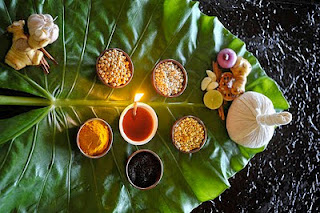Saar is the result of properly nourished dhatu (tissue quality) and is the essence or quality check of the dhatu. If the dhatu are made of bad quality food for example, then saar is compromised.
Its
assessment is an essential part of patient examination to determination the
overall strength of the patient (Pravar bala, excellent strength, Madhyam
Bala, medium strength, or Heen Bala, low strength). Determining
their saar, along with other factors such as age, habits, constitution
or mental strength for example, helps to decide where and how any intervention
would best be made.
However
we can also talk about people being one kind of saar person or another. It is
difficult to determine the optimum weight of a person, or how they should look
at their best, without knowing their saar. If a person has weak bones
(deficient asthi saar) or other dhatu are not good but rakhta
dhatu is strong, Ayurveda considers that person a rakhta saar
person. It could be their genetic constitution or a blockage which could be
determined with rogi pariksha, diagnosis of illnesss.
1.
Tvatcha saar pariksha
These people have skin which is healthy,
neither thin nor thick. They tend to be enthusiastic people with good energy
levels.
2.
Rakta saar pariksha
Reddish hands and feet, reddish flush on
chest, skin pinky red, eyes and tongue red
These people are intelligent and
excitable, they can get angry quickly and suffer from skin diseases. They have good
rakhta dhatu.
3.
Mansa saar pariksha
They build strong (not necessarily big) muscles quickly. These people can be a little proud, and selfish.
4.
Meda saar pariksha
Their ears, eyes, skin, lips are
oily/moist, that it they have excellent meda dhatu. These people are
generally happy, content and satisfied. Their touch is soothing and very kind.
5.
Asthi saar pariksha
These people have big, sturdy bones, a
big frame, good hair. They are generally brave, (very courageous in battle) and
generally happy.
6.
Majja saar pariksha
These people´s skin is fine but strong,
moist and wrinkle free, their eyes look very content and loving. They tend to
feel a lot of satisfaction and contentment, and have strong immunity.
7.
Shukra saar pariksha
These people are naturally very
attractive to the opposite sex. The women are said to be curvy with large breasts and hips
and good skin, while the men are said to be virile, with large sexual organs, and both
smell very good. These people are fertile and can have many children if they
want to.
8.
Sattva saar pariksha
People with sattva saar have a
very strong mental capacity, are
intelligent and well mannered, have good common sense, are not easily confused,
and solve problems quickly. They like to speak. They are generally happy,
content, pure, and they attract others with their problem-solving abilities,
and their inspirational qualities. They can make excellent inspirational
speakers.
There
are three classification of saar:
Uttam
saar, supreme saar
person, very healthy and strong, has all the genetic advantages
Madhyam
saar, middling health and
strength
Heen
saar, least health and strength,
prone to sicknesses
Someone
with Heen Saar or Madhyam Saar can maintain and strengthen their dhatu
strength/ saar, (although they may never be as strong as someone with a
genetic advantage) If someone has Heen Saar they must take even more
care of their health.
We
should always try to find out the optimum level for that individual. Have they
been stronger or more vital in the past? The point of comparison should always be to
their own best health, not to the health or strength of others.
For
example, someone seems very pale, grey or very thin. Are they naturally pale or
anaemic? Are they underweight for their constitution and saar, or are
they naturally slender? We could say
that it is difficult to establish in the case of someone who has never known
optimum health and vitality even in childhood, but that in itself may give
pointers to genetic weakness and the need for strengthening of dhatu
through diet, breathing and lifestyle.






